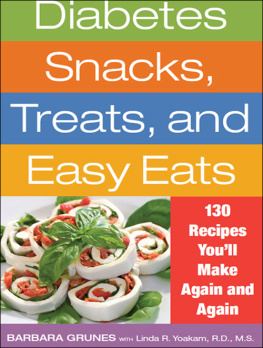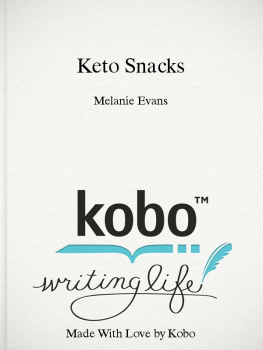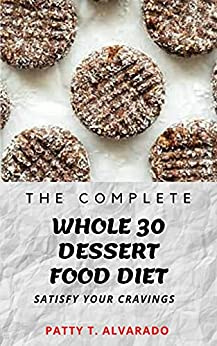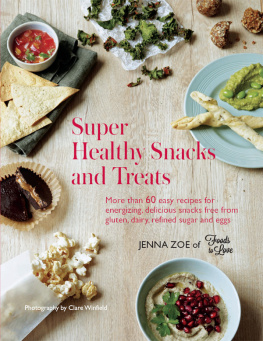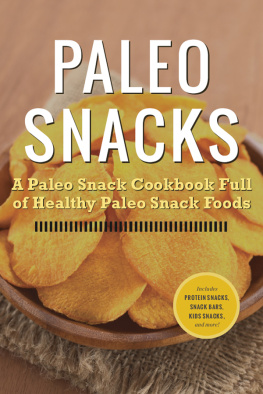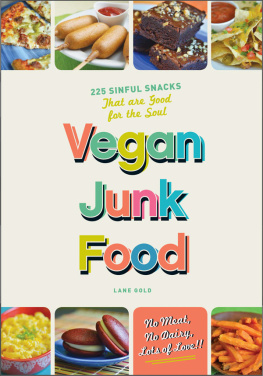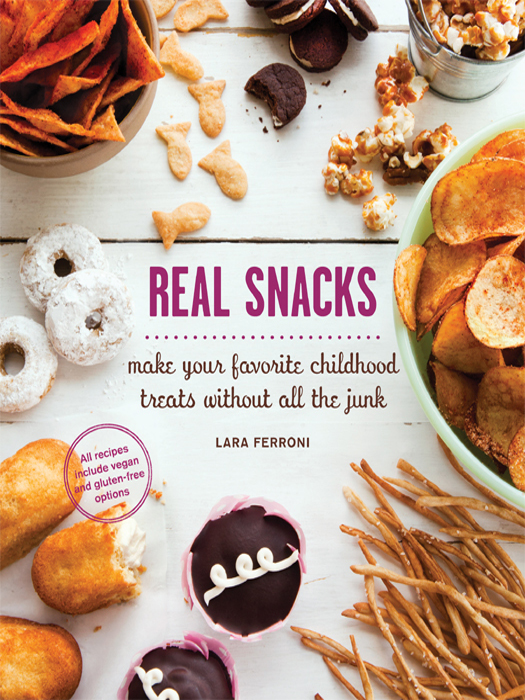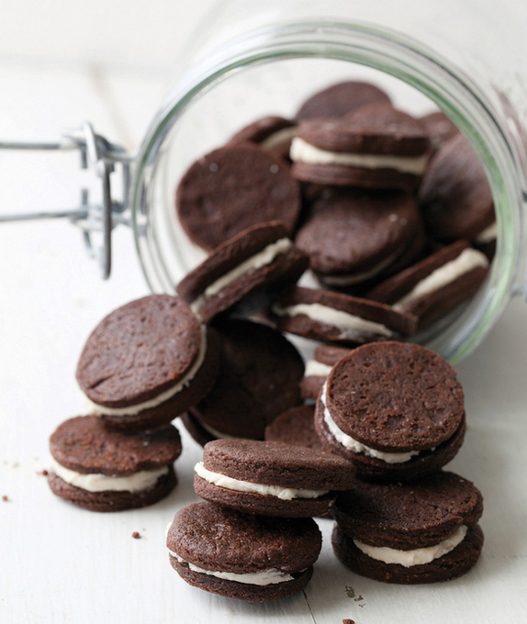

Copyright 2012 by Lara Ferroni
All rights reserved. No portion of this book may be reproduced or utilized in any form, or by any electronic, mechanical, or other means, without the prior written permission of the publisher.
Published by Sasquatch Books
Cover and interior photographs: Lara Ferroni
Cover and interior design: Anna Goldstein
Library of Congress Cataloging-in-Publication
Data is available.
eISBN: 978-1-57061-838-3
Sasquatch Books
1904 Third Avenue, Suite 710
Seattle, WA 98101
(206) 467-4300
www.sasquatchbooks.com
v3.1
CONTENTS
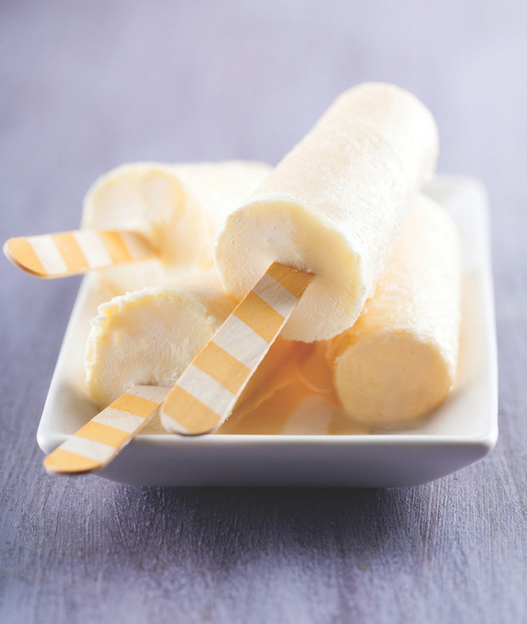
real sweet
Snack Cakes
Cookies
Frozen Treats
Confections
real salty
Crackers
Chips
Dips
Other
appendix: the real snacks pantry
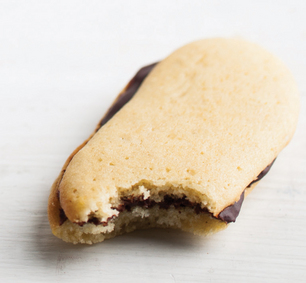
Thanks to my mom for teaching me good sense when it came to eating. Junk food snacks may have been mostly reserved for road trips, but they were never such a taboo as to make them irresistible. Wish I could have shared some of these recipes with her.
Thanks to my recipe testers for making sure that what was in my brain made it to the page and for sharing your honest feedback.
Thanks to Kim Boyce, owner of BAKESHOP in Portland, Oregon, for inspiring me to delve deeper into whole grains with her gorgeously written cookbook, Good to the Grain, and with her irresistible figgy scones.
Thanks to Susan, Michelle, Rachelle, Anna, Christy, and the gang at Sasquatch for helping me turn this wacky idea into a beautiful book!
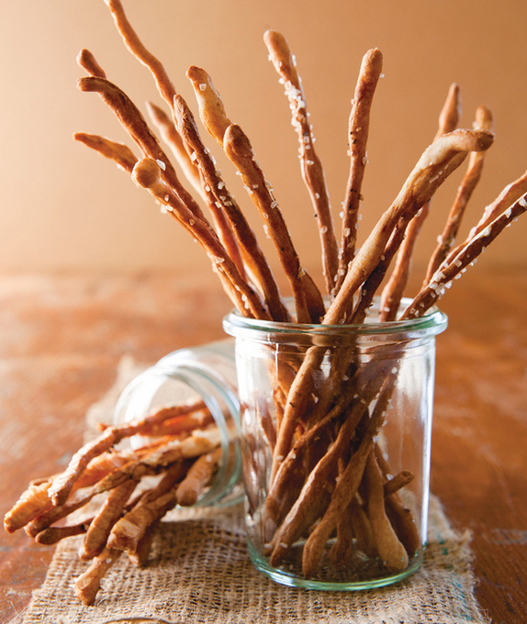
The supermarket aisles are full of foods that I love, much of them convenience junk foods packed with equal parts favorite childhood memories and industrial additives. The nostalgia of these foods gives me cravings that are often far stronger than I can resist. Who hasnt had a jonesing for a handful of cheesy Goldfish crackers or gotten just a little bit giddy at opening a package of chocolatey Ding Dongs? Sweet or savory, we all have our favorite snack foods.
The guilt sets in when I turn that packaging over and read the laundry list of gums, ides, and ates, not to mention added artificial colors and flavorings. Natural food producers have created a whole industry to address this guilt, creating their own versions that are just as convenient, but slightly less processed, than the big-name brands. Unfortunately, these are usually far more expensive than their industrial originals, and, lets face it, not as tasty. Carob is no substitute for chocolate, and lentils do not replace potatoes in a chip, even when the potato has been processed beyond recognition.
Its time to take back our snacks!
This book is all about re-creating favorite childhood snacks, reimagined with more nutritional ingredients (like whole-grain flours and less-processed sugars) that amp up the flavors and textures. These standard pantry items can be found in any grocery with old-world whole grains and other unprocessed ingredients. And for those with gluten sensitivity or who prefer vegan treats, these recipes offer some suggestions for you. The recipes in this book arent intended to be low-calorie. They are simply real food that I think youll love to indulge in now and then.
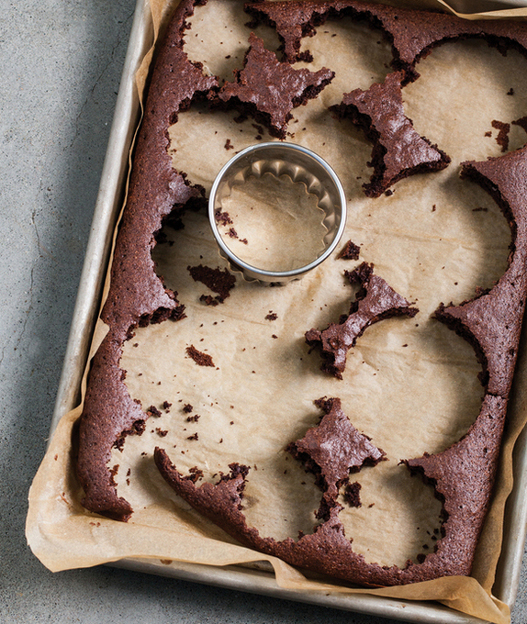
Baking with only white flour and white granulated sugar is sort of like cooking with only one spice. There is a world of grains and sweeteners with their own flavors and textures just waiting to be incorporated into your baking. Not only will they make your treats more healthful, but they will also make them taste better!
flours
While its easy to stop at white all-purpose when you think of flour, there are all sorts of flours that each bring a little something extra to snacks. Understanding the flavors and textures of these flours is important when you decide to incorporate them into your cooking.
Flours with Gluten
BARLEY FLOUR
Barley flour brings a slight sweetness to your baked goods, along with a good amount of dietary fiber. Adding a bit in place of wheat flour makes for very tender baked goods, so its best used for cakes or pastries that benefit from the extra lightness.
GRAHAM FLOUR
Graham flour is a blend of coarsely grown 100 percent whole-wheat flour with all-purpose white flour. You can buy graham flour already blended, or make your own to use as a great general substitute for straight all-purpose flour.
RYE FLOUR
When it comes to rye flour, forget about the strong aroma of rye bread, which comes from the caraway seeds in the dough rather than from the grain. Rye actually has a very subtle wheat-like flavor that is just a bit more complex than traditional whole-wheat flours. Its a great flour to use in chocolate baked goods.
SPELT AND KAMUT FLOURS
Spelt and kamut flours are in the same family as wheat flour, but they have a lower gluten level that is more easily tolerated by people with mild gluten intolerance. Because they still contain gluten, spelt and kamut flours can easily replace wheat flour in most recipes, but they are not recommended for those with celiac or severe gluten allergies.
WHOLE-WHEAT FLOURS
There are many different types of whole-wheat flours suited for different purposes; they all contain the full goodness of the grain. The recipes in this book will often call for white whole-wheat flour (processed the same way as regular whole-wheat flour, but made from hard white spring wheat instead of red wheat), whole-wheat pastry flour (more finely milled, lower protein soft wheat), or traditional whole-wheat flour. You can easily substitute spelt flour (either white or whole-grain) for these flours.


